Elephants -- School-age
Elephants
Things to Know
Elephants are the strongest and largest land mammals on Earth. There are two primary species of elephants living today: the African elephant and the Asian elephant (also known as the Indian elephant). There are sub-species of each species. The scientific name for African elephants is Loxodonta africana and the Asian elephant name is Elephas Maximus
Range
Elephants live in hot climates in sub-Saharan Africa, South Asia, and Southeast Asia.
Distribution of elephants.
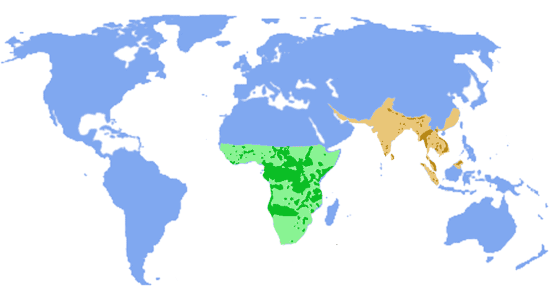
Diet
Elephants are herbivores. They can spend 16 hours a day collecting bark, bamboo, leaves, twigs, and roots. The diets of African elephants comprises mainly of leaves and Asian elephants diets is mainly grass. They eat 300-600 pounds of food everyday and drink 40-50 gallons of water everyday. It is not uncommon for an elephant to tear down a tree to get the leaves. Elephants use their trunks to churn up the ground and placing The elephant then places pieces of soil into its mouth to obtain nutrients, supplementing its diet with salt and minerals.
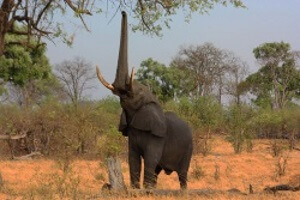
Body
Size
Elephants are the largest land-living mammal in the world. African elephants are larger than Asian elephants.
African male elephants height at the shoulder, 8.2 to 13 ft. (2.5 to 4 m) and weigh 2.5 to 7 tons (2,268 to 6,350 kg) while Asian male elephants height at the shoulder, 6.6 to 9.8 ft. (2 to 3 m) and weigh 2.25 to 5.5 tons (2,041 to 4,990 kg).
Ears
Elephants ears help regulate their temperature. The ears are thin and are made up of a complex network of blood vessels which help regulate their temperature. As the ears are thin, flapping them cools the blood that is inside the ear flap. Blood is circulated through their ears to cool them down. African elephants ears are shaped like the continent of Africa.
Tusks
The tusks of an elephant are modified incisors teeth. Both male and female African elephants have tusks. Asian male elephants have tusk, but not all have them. Female Asian elephants do not have tusks. Elephants use their trunk for breathing, smelling, breathing, caressing their young, sucking up water, and grasping objects.
Trunk
Elephant trunks are muscular and flexible. The trunk is an extensions of the upper lip and nose of an elephant with two nostrils running through its full length. Elephants use their trunk to dig, lift up food and suck up water then pour it into its mouth.
There are major differences in the trunks of the two elephant species. An African elephants trunk is more ringed and not as hard as the Asian elephants trunk. The African elephants trunk consists of two finger-like growths at its tip while Asian elephants have only one finger-like growth at its tip.
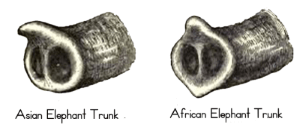
Skin
An elephant's skin can be as thick as 1 inch (2.5 cm). The skin is sensitive to the sun. An elephant uses mud as a sunscreen, wallowing in the mud to protect itself from sunburn, insect bites, and moisture loss. The African elephant skin is much more wrinkled the Asian elephant's skin.
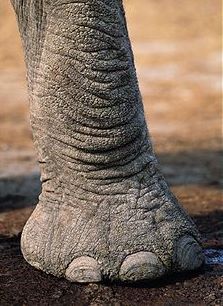
Legs
Elephants have wide think sturdy legs. Most four-legged animals use their front legs to stop and their back legs to go. An elephants manner of walking is different than other four-legged animals. Each limb is used for braking and acceleration, all four legs work together. Each leg is used for used for both braking and accelerating.
Elephants have bendy knees. They can knell on its front legs. Despite having knee joints an elephant cannot jump. It is thought that an elephant is unable to jump due to its size. The legs are built to support the elephants weight.
Feet
The underneath of elephants feet is made up of tough and fatty tissue so elephants can walk quietly. The foot of an elephant has toes that are buried in the flesh of their feet. The toenails of the different elephant species vary. The Asian elephant has 5 toenails on its front feet, 4 on the back. The African forest elephant has 5 toenails on its front feet and 4 on the back while the African bush elephant has 4 toenails on its front feet and 3 on the back.
Elephant Species Differences
Family
A male elephant is called a bull. A female elephant is called a cow. A baby elephant is called a calf.
Female elephants live in large groups called herds. The herd is made up of 10 or more with mothers and offspring. The herd is led by the matriarch which is often the eldest female. Males leave the herds around age 14 and live fairly solitary lives, they join a loose-knit band of other bull elephants leaving it at mating time.
Fun Fact
Elephants like to swim. They use their trunk to breathe, like a snorkel, in deep water.
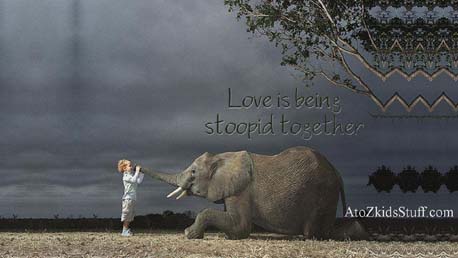
1024 x 768 or 1600 x 900
Elephant desktop wallpaper courtesy of Breezy
Story
Elmer (Elmer Books)
by David McKee
Kids Craft: Elmer Elephant
Plastic milk jug and tissue paper makes an easy elephant art project.
Milk Jug Elmer Elephant Craft
Gallon milk jugs used.
Video
Things to Do
Sites to See
Elephants
Literacy, Math, Make It, and more.
Asian Elephants
Elephants under threat.
Elephant Concentration Cards
Print and play concentration.
See Also












